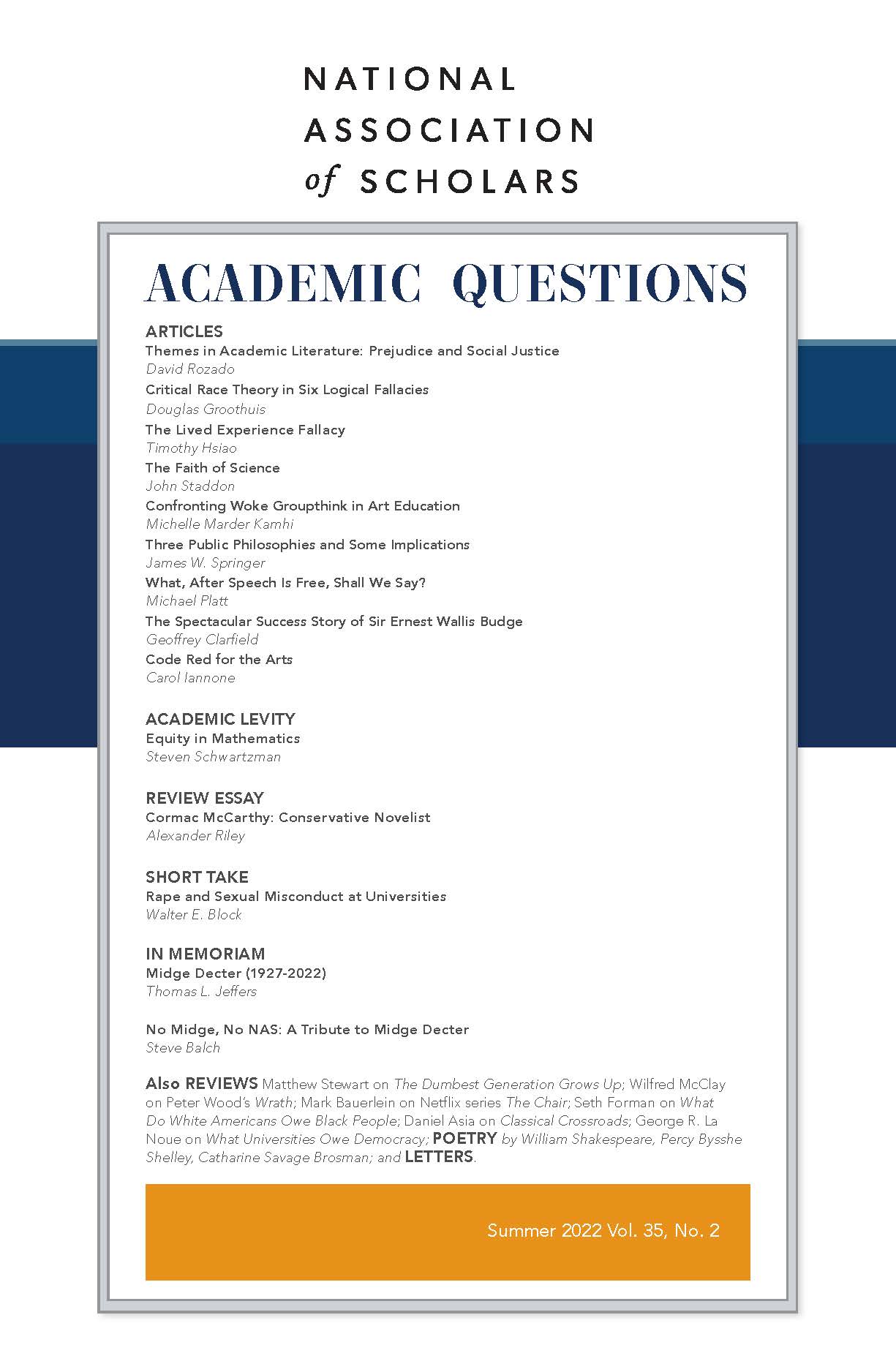Carol Iannone is editor-at-large of Academic Questions, 420 Madison Ave., 7th Floor, New York, N.Y. 10017; [email protected].
The current repudiation of Russian art and artists due to Putin’s war of aggression against Ukraine is a sad sign of how globalism is overtaking us. So far from broadening perspectives, it is squeezing us into a worldview where everything is politicized, and taking sides in every context is the only way to understand our circumstances.
This brings to mind a wonderful film which celebrates the luminous capacities of art to transcend boundaries and also, by the by, unembarrassedly celebrates the glory of cultural appropriation. The Red Violin (1998), directed by Francois Girard, who also co-wrote it with fellow Canadian Don McKellar, tells of a surpassingly perfect violin created with a special secret by a fictional Stradivarius-level master in Italy in 1681 and its beautiful, bracing, sorrowful history through the subsequent centuries up to the present.
The similarity to recognizable elements in European musical history continues throughout as the violin ranges over countries and continents, becoming a metaphor for the irrepressibility and universality of art. After a sad beginning (via the special secret), the violin is donated to an orphanage where it is briefly in the hands of a Mozart-like child prodigy who learns to play it brilliantly but sadly dies prematurely. In tribute to the little master, the monks in charge of the orphanage bury the violin with the child, but, again, as if to illustrate the undying life of art, it is stolen by grave robbers who pass it on to a group of gypsy travelers on their way through Europe. Their ecstatic playing inspires an English virtuoso in the late nineteenth century who composes for it and plays it thrillingly in concert, with the gypsies in attendance. When he dies, also in sorrow, his Chinese manservant sells it to a secondhand dealer in Shanghai who hastily repairs it of the damage it endured during a tempestuous romantic altercation between the unfaithful virtuoso and his angry erotic muse. It is there purchased by a female violinist for her daughter in the 1930s. We next see the daughter as a grown woman, a teacher in the midst of Mao’s Cultural Revolution, in which Western musical instruments have been declared bourgeois and forbidden; they are among the “olds”—Old Ideas, Old Culture, Old Habits, and Old Customs—declared useless in the brave new communist world.
During a revolutionary presentation day at the school, the students perform a specimen of communist art, complete with flags and bayonets, meant to “teach and inspire the people” with collective ideals. The presentation is not without some rousing appeal and choreographic energy but might suggest a summer camp production meant for visiting parents (minus the bayonets), and couldn’t be further from the mature interiority of the orchestral music that we have been hearing on the radiant soundtrack composed by John Corigliano with gorgeous violin solos performed by Joshua Bell.
Next on the school program is a perversely fascinating Red Guard struggle session in which transgressors against the cultural orthodoxy are berated and humiliated for the edification of the students and faculty. A very young and chillingly convicted female commissar in her party uniform upbraids an older man who has been teaching Western music. He cowers under her reproaches, and stammers his agreement that Western music is decadent, something we feel pretty sure he doesn’t really believe, but he tries to salvage what he can by proposing Beethoven and Prokofiev as “revolutionary.” The imperious commissar with her jaunty braids cuts him short and snaps out the tone-deaf party line. What is this “symphony,” “concerto,” “No. 1, No. 2, No.3,” she demands. “This is empty formalism. It speaks nothing to the people.”
When the film emerged almost twenty-five years ago, and even some time after that, it was still possible, believe it or not, to see the Maoist spectacle as distant from our situation. But that was before Evergreen and Middlebury and Yale and Princeton and NYU. The scene can now remind us of the young commissar’s ideological cousins, our own contemporary cultural brownshirts, spitting out their accusatory epithets at professors and visitors, with college presidents and other administrators looking on approvingly, completely abandoning their loyalty to the humanities, the liberal arts, and the ideals of Western education altogether. I’m quite sure that on my first viewing, there hadn’t yet been the groveling apologies demanded for supposed transgressions, the anonymous hot-line reports of verbal deviations, the swarms of students accusatorily surrounding or confronting or stalking faculty and speakers to denounce and silence and sometimes threaten them, the pious elimination of intellectual and literary standards in the name of “equality” and “equity” (or “the people”), the chilling of speech and the freezing of thought, and the denunciation of the great Western cultural legacy as “white supremacy” by students and faculty openly parading their ignorance. The new party line had certainly begun to be formed but was not yet ascendant and not as pervasive.
It probably shouldn’t have been, but it was a surprise to discover how thoroughly ideas arising from Critical Race Theory had saturated even lower education, something that came to light for many parents whose children had to attend school online during the pandemic. The 1619 project hadn’t yet begun to falsify history and instruct children to define themselves through hatred and lies. A litany of further miserable developments could be cited, and the list is amplified day by day.
True, radical ideas were pulling liberalism further and further left in those days, in the perennial pattern Solzhenitsyn sketched in his Harvard speech, but were still being vigorously contested (in what some, perhaps naively, thought was a fair fight), and hadn’t yet hardened into progressivism and the sweeping anti-white wokeness, often explicitly vicious, of today. New York magazine had a splashy cover story on the PC phenomenon in 1991 that was fair, substantive, and seriously concerned about the threat presented to a free society. Political correctness had even become a subject in art and entertainment. Seinfeld treated it humorously in more than one episode (and then found the rules of permissible discourse had become more stringent a few years after they went off the air). More seriously, a couple of good plays by prominent playwrights had already emerged calling attention to the developing clash of academic cultures coming into view. I discussed these dramas in “PC on Stage” in AQ Winter 1993—A.R. Gurney’s Another Antigone (1987) and David Mamet’s Oleanna (1992)—about professors caught in the trap of traditional standards challenged by changing student demands. And true, both professors are defeated by the new dispensation, but in the manner of exposure, in the tradition of plays about injustice. Perhaps most memorable is the portrait both dramas present of a new type of student-tyrant, fluorescing through discovery of grievance and oppression.
The teacher being denounced in the film is forced to put his violin in its case on a fire consuming other “olds,” and at first we are horrified to think it may be the magnificent red violin. But soon we see the female teacher, the now grownup little girl for whom her mother bought the instrument years ago, unearthing it from a hiding place in her quarters. Her young son finds her with it and she plays a few exquisite bars of music for him (the Red Violin theme, played by Bell as an extra at his concerts). He listens with concentration, his eyes behind his thick glasses regarding the unfamiliar instrument, hearing what he has never heard before. Maybe the violin does speak something to “the people” after all. She smuggles the instrument to the music teacher and he manages to keep it safe until the winds change in China and it can come into the open and go on auction as the precious marvel of musical construction that it is. In a poignant moment we recognize a young man among the bidders, the little boy with his thick glasses, now a grownup businessman, probably, successful enough to be at an auction where expensive objects are being sold. Also bidding via telephone is the order of monks from the orphanage. The film is as visually appealing as it is auditorily, with marvelous production values conjuring up each period in its appropriate context and color.
At the end of the film, the auction is over and the red violin goes to the wrong person, or so it seems. He has the almost two million dollars to afford it, but, despite evidently being a violinist himself, cannot really hear and savor its superlative sound. It turns out adjustments have been made. The expert appraiser for the auction, in love with the red violin, had a substitute made and switched the two instruments behind the scenes just before the auctioneer began the bidding.
Does the metaphor continue? Those who cannot appreciate beauty do not deserve to have it, and the legacy endures among those who can love and cherish it?
It seems so. The Maoist revolution destroyed China’s traditional culture and arts, but these are being maintained in the Chinese diaspora through the dazzling artistry of the Shen Yun spectacles. And Maoist tyranny could not wipe out the Chinese affinity for Western music, as we can readily see at concerts. This can inspire us as we continue the fight to protect our heritage from the barbarians.













